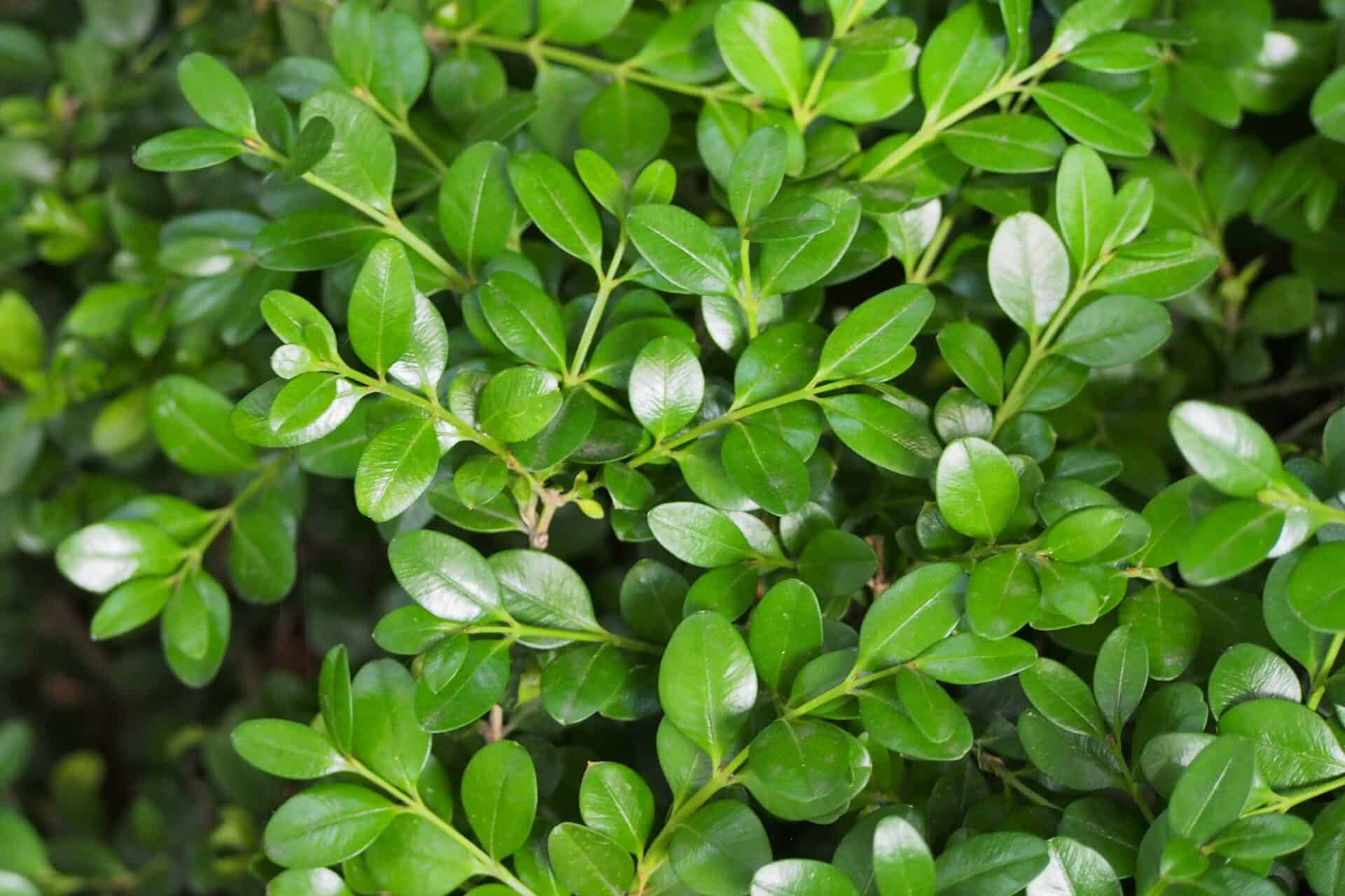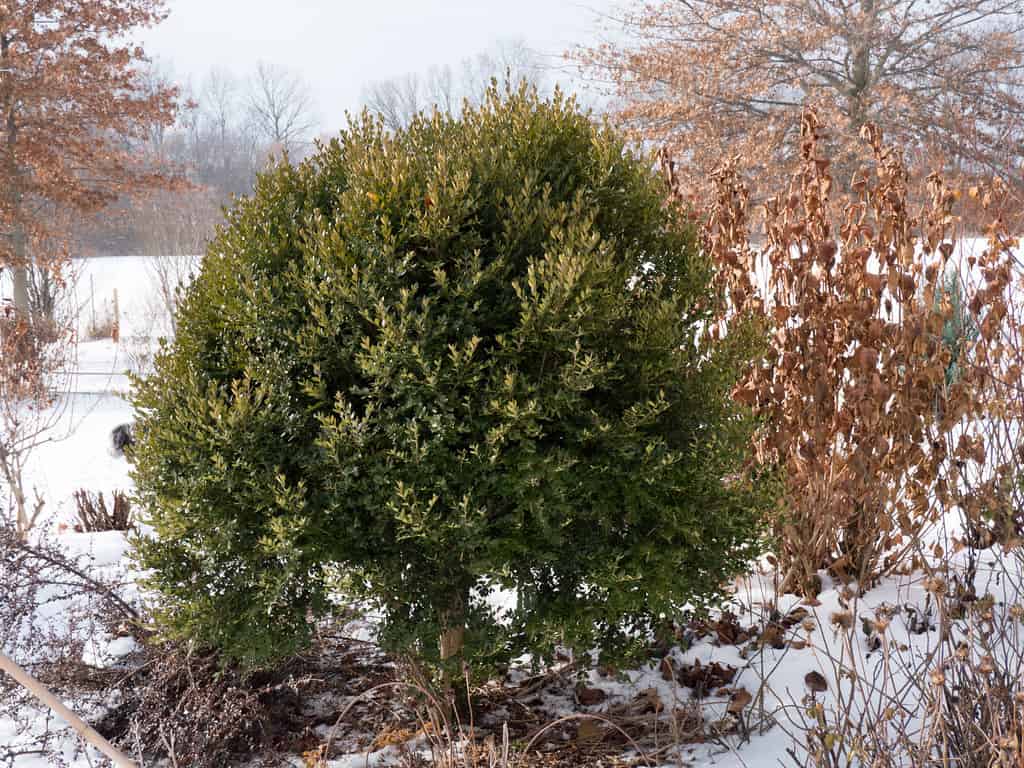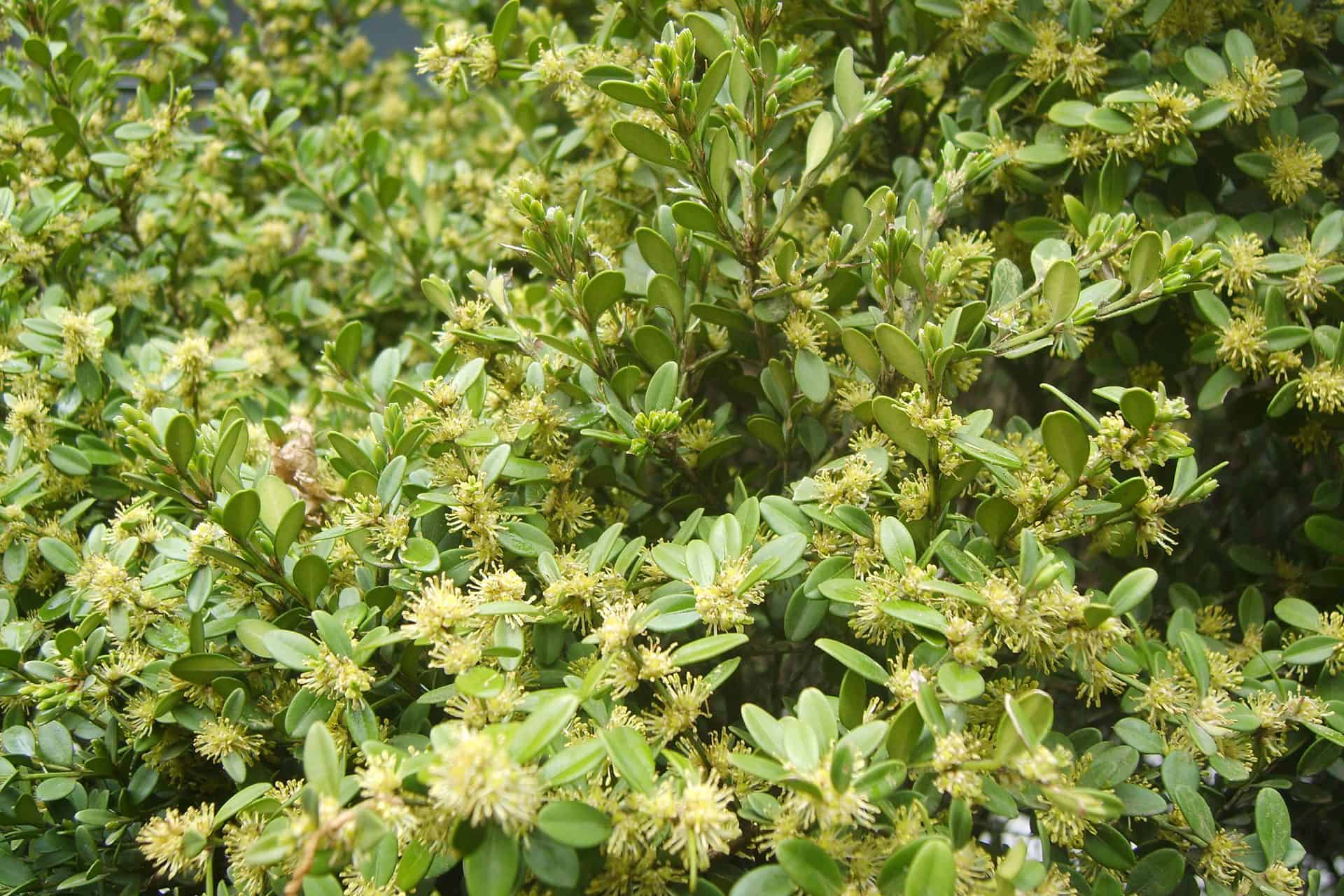No products in the cart.
Among the oldest known garden plants is the Green Mountain boxwood shrubs. This variety is believed to have existed since 4000 BC and has been a favorite landscape feature whether as an accent plant, border, or hedge plant.
Green mountain has a pyramidal shape and bright green foliage which is evergreen. It will perfectly fit different types of the garden including an English garden, a pollinator garden, and a winter garden.
PLANT NAME: Buxus x ‘Green mountain’
Other Name: Boxwood, Green Mountain boxwood
Plant Type: Shrub or small tree
Native Areas: Europe and Asia
Light Requirement: Dappled light, full sun, part shade
Watering: Medium watering
Fertilizer: Apply a liquid, balanced fertilizer in early Spring
Toxicity: Mildly toxic to pets and humans
Temperature:
Propagation: Stem cuttings
Growth: Moderate (4 inches per year)
Soil Type: Evenly moist and well-drained soil (sand-clay mixture)
More About Green Mountain Boxwood
The term Buxus is a Latin name that means box, hence the common name boxwood or box tree is born. Buxus is a broad genus containing about 70 species of evergreen shrubs and trees.
The Buxus ‘Green Mountain’ is just a member of this genus, a cross between two parent species: English (B. sempervirens) and Korean (B. microphylla). It was developed in Sheridan Nurseries located in Canada.
Because of its upright and pyramidal form, the Buxus ‘Green Mountain’ is sometimes treated as a small tree. But in nature, it’s a shrub type of plant reaching a mature height of five feet on average. It spreads up to three feet creating a dense and lush mound of foliage in your garden.
The individual leaf itself is small, only less than an inch in length. It has an elliptical shape, arranged oppositely. It has a glossy feel and green color. While the mountain boxwood also produces flowers during Spring, they’re often significant because they’re tiny.
However, they’re fragrant enough to attract bees.
Green Mountain boxwoods have a hardy nature. It’s tolerant of harsh winters, urban pollution, and drought. At the same time, it’s resistant to deer and rabbits. Planting boxwoods is beneficial if you want a tight hedge around your yard or a potted accent shrub on your balcony.
Green Mountain Boxwood Care

Except for regular pruning, Buxus ‘Green Mountain’ will require low maintenance in your landscape. Even during winter, your Green Mountain boxwoods will maintain their vibrant green foliage. Once established and mature, Green mountain boxwood outdoor plant care is relatively easy.
Ideal Potting Mix
You could use different types of soil including clay, loam (silt), and sand. However, keep in mind that well-drained soil is preferred. A mixture of sand and clay will create a structure that retains enough moisture but also drains excess water.
This is ideal for growing plants like Buxus Green Mountain. There’s no specific pH range to maintain as this plant will thrive in acidic, neutral, or alkaline soils.
Lighting

Buxus x Green Mountain isn’t even very picky when it comes to light requirements. It could thrive in a variety of light conditions whether it’s full sun to partial sun or partial shade with several hours of morning sunlight. However, beware of exposure to intense direct sunlight as it could bring stress leading to leaf scorching.
So if you live in a warm region, you better plant your Green Mountain boxwoods under dappled conditions.
While this plant can grow under some degree of shade, we don’t recommend growing it under full shade. This will result in less vigorous plants with less vibrant foliage.
Watering
Consistent watering of the Green Mountain Boxwood is critical during its young and juvenile stages. Make sure to water twice a week deeply as this would help them establish a good and strong root system. Avoid light-watering new plants because it will result in very shallow roots.
You could also provide 2 to 3 inches of mulch around its base to conserve moisture.
Once established, the Mountain boxwood is fairly drought tolerant. This means that they’ll require less frequent watering. However, it’s important to keep the soil evenly moist.
And during the hotter days, you may need to provide supplemental irrigation rather than rely on occasional rainfall.
Temperature and Humidity

Areas under USDA hardiness zones 5a to 8b offer the best-growing conditions for Green Mountain boxwood. It’s hardy in temperatures as cold as -10 to -20°F (-23.33 to -28.88°C). So even in the freezing winter, your mountain boxwood shrubs will remain alive.
Fertilizer Needed
Green Mountain boxwood isn’t a heavy feeder. You can apply a balanced, slow-release fertilizer during the early Spring and it will help boost its growth. Cease fertilizer application at least three to four weeks before the first frost.
Pruning
Pruning is an important management practice in Green Mountain boxwood shrubs especially if want to maintain a well-kept topiary. Prune your shrub to your desired size and shape using a clean and disinfected shear. Remove the old branches, the faded blooms, and the diseased parts (if any).
Avoid pruning in late fall because the cold winter will damage new growths making it hard for the whole plant to rejuvenate.
Can we pot green mountain boxwood?

Aside from directly planting Green Mountain boxwoods in the ground, you can also plant them in pots. However, their growth and size will be limited because their roots will be bound in the container. But this is a good option if you have limited space.
The key to potting a mountain boxwood is to choose a pot that has a bigger diameter than its rootball. Make sure to pot it carefully without damaging the roots. Newly potted indoor plants normally experience transplant shock for a short period and then recover. But if potting isn’t done well, it could lead to eventual death.
Propagation
It would be easy to propagate a Mountain boxwood using stem cuttings. Here’s a simple process:
Take healthy cuttings from a lush plant having at least 4 inches of length. It’s best to take cuttings from the fresh growths rather than the older stems.
Once you clip them, strip off the lower leaves and retain only a few on top.
Now, you have the option to dip the cuttings into a rooting hormone to speed up the rooting process. But you can also forego this step.
Plant the cuttings in a potting medium. You can place two to three cuttings in one pot. Keep the medium moist because it will help the cuttings develop roots.
Wait for about 4 weeks for your cuttings to have their roots. You can transplant them later in a bigger container.
Green Mountain Boxwood Similar Plants
There are other boxwood varieties you’ll encounter. And these are the following:
English Boxwood

English boxwood is the most common boxwood variety. It’s also one of the parent plants from where the Green Mountain boxwood is bred. It has a rounded shape, with a mature height of three feet.
American Boxwood

American boxwood grows high, ranging between 10 feet to 20 feet high when mature. It’s also commonly known as the common boxwood. If you want to establish a higher, long-lasting hedge, this variety will serve that purpose.
Korean Boxwood

Korean boxwood is the other parent plant of Green Mountain. It’s distinct from other boxwoods because it has an open growth habit, which allows better air circulation and sun penetration. This variety grows an average height of four feet.
Green Mountain Boxwood Common Diseases and Pests
Pests such as boxwood leafminer, boxwood psyllid, and boxwood mite can sometimes bring trouble to your mountain boxwood. They usually attack when the shrubs are planted in poor conditions making them susceptible. The key to avoiding them is to create an environment that favors the growth of your shrub.
A fungal disease known as boxwood blight is also a problem in Green Mountain boxwood shrubs. They attack the leaves creating leaf spots that later result in leaf browning and leaf drop. This disease could defoliate the whole shrub and lead to its dieback.
Make sure to immediately remove the infected plant to prevent its spread. You may use fungicide sprays on other plants to protect them from infection. If you want to completely avoid this blight disease, opt for disease-resistant varieties of boxwoods.
Frequently Asked Questions
Both varieties are almost similar in appearance but the Green velvet is more suited for hedges and ball topiaries while the Green Mountain is for pyramids and cones.
Compared to other boxwood varieties that are slow-growing, the Green Mountain boxwood has a moderate growth rate. This means that it grows a little faster than its relatives. On average, it produces about 4 inches of growth per year.
Yes. You can shape a Green Mountain boxwood to create a topiary in your garden.
A mature Green Mountain boxwood could grow up to five feet high and three feet wide.
You can get another variety which is the Japanese boxwood here at Plantly. The starter plant is less than 12 inches and can be shipped through USPS where you’ll be provided tracking information and shipping cost. Buy it now!
Whether you want to buy, sell, or simply reach out to other plant enthusiasts, Plantly is the right place to be!


